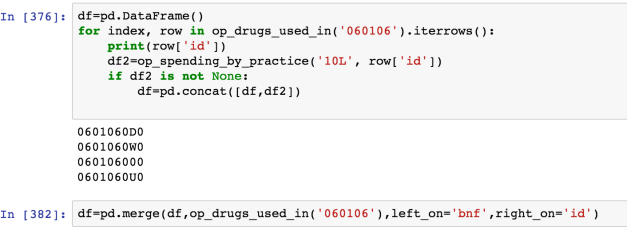Last year, I had a quick dabble with creating Data Driven Press Releases From HSCIC Data based around a diabetes prescribing data release. Noticing that the figures for 2015/16 had been released over the summer break, I revisited last year’s script to see it if works with this years data – which is does, save for a few tweaks to the import of the spreadsheets.
So this year’s report for the Isle of Wight is as follows, constructed automatically from the data by looking across several sheets in two spreadsheets:
Figures recently published by the HSCIC for the NHS Isle Of Wight CCG show that for the reporting period 2015/16, the total Net Ingredient Costs (NIC) for prescribed diabetes drugs was £2,579,592.41, representing 9.95% of overall Net Ingredient Costs. The NHS Isle Of Wight CCG prescribed 137,741 diabetes drugs items, representing 4.28% of all prescribed items. The average net ingredient cost (NIC) was £18.73 per item. This compares to 4.14% of items (10.31% of total NIC) in the Wessex (Q70) region and 4.61% of items (10.57% of total NIC) in England.
Of the total diabetes drugs prescribed, Insulins accounted for 21,884 items at a total NIC of £1,071,880.50 (£48.98 per item (on average), 0.68% of overall prescriptions, 4.13% of total NIC) and Antidiabetic Drugs accounted for 94,347 items at a total NIC of £890,424.84 (£9.44 per item (on average), 2.93% of overall prescriptions, 3.43% of total NIC). Diagnostic and monitoring devices accounted for 20,485 items at a total NIC of £605,971.30 (£29.58 per item (on average), 0.64% of overall prescriptions, 2.34% of total NIC).
For the NHS ISLE OF WIGHT CCG, the NIC in 2015/16 per patient on the QOF diabetes register in 2014/15 was £330.42. The QOF prevalence of diabetes, aged 17+, for the NHS ISLE OF WIGHT CCG in 2014/15 was 6.61%. This compares to a prevalence rate of 6.37% in Wessex and 5.83% across England.
Creating reports for other CCGs is simply a matter of changing the CCG code. On the to do list is pull dat from last year as well as this year into a simple database, and then write some more sentence templates that compare the year on year performance. (I also really need to have a think about a more sensible way of generating sentences!)
After an interesting chat last night with Gary Warner from Island based Pinnacle Health Partnership, a social enterprise providing backend services for community pharmacies, I thought I’d have a poke around what services are out there based on the NHS open prescribing data, as a short cut to population my own databases with the original data (each month’s dataset comes in around 1GB).
OpenPrescribing.net seems really useful in this respect, at least as a quick way in to summaries of the data – the API allows you to pull down data by CCG, as well as GP practices within a CCG, and break out prescriptions by item using BNF codes. A handy look up service also helps find items by BNF section, such as Drugs used in diabetes (BNF 6.1).
I’ve posted a quick sketch notebook as a gist, also embedded below. But here’s a quick glimpse at some of the first reports I had a look at generating. For example, we can look at the spend associated with particular BNF section codes broken down by GP practices in a particular CCG area:

and then group it by period (I made a crude guess at the financial year but I’m not sure what the dates in openprescribing actually relate to…) so the aggregates are indicative only. The aggregate value over the CCG for item counts seems to be broadly in line with the NHS Diabetes Prescribing report, which I took as weak confirmation that it’s sort of working!

We can also use the API to look up items by BNF section:

If we loop round the items in a BNF subsection, we can generate reports about the prescribing of particular items within that subsection across practices, merging in the item names to make them easier to identify:

The pandas charting tools aren’t brilliant – after the Yhat refresh of ggplot (for python), I think I need to revisit that library when tinkering in the python context – but we can do crude sketches quite easily.

Anyway, playtime over. It was interesting to give the openprescribing,net a go, and give a chance I’ll try to play with it a bit more to explore some more quick reports to add to the diabetes notebook.